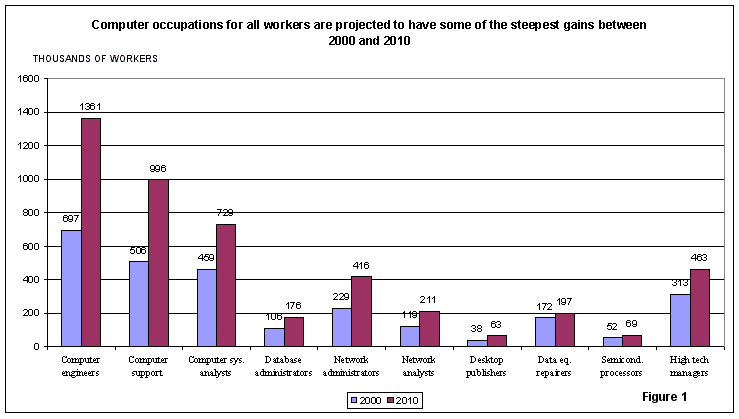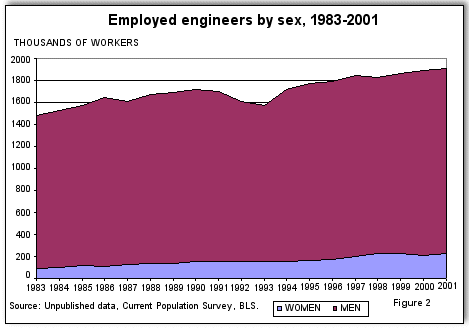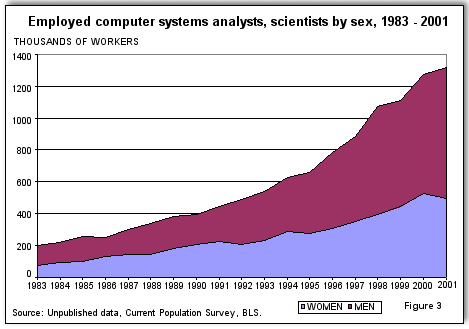
No. 02 - 01
July 2002
WOMEN IN HIGH-TECH JOBS
Text
Version

Why is there so much excitement about
“high-tech” in today’s economy? Over the past decade,
high-tech jobs have shown substantial growth. Women, therefore, need to
recognize that in addition to paying well, these jobs are key in the changing
economy of the 21st Century and should receive serious consideration as career
choices. Projections for future growth indicate that computers, software, and
applications for information technology will continue to have a substantial
impact on lives and employment opportunities in the United States.
Use of the Internet and wireless technologies has exploded,
creating phenomenal growth and new challenges for manufacturers of this
equipment.1 Figure 1 shows the projected increases in
occupational employment in computer-related jobs. “High-tech,”
however, goes beyond computers, software, and the Internet. A broad spectrum of
industries and occupations is considered “high-tech.”
What does “high-tech” or
“high-technology” mean in the United States today? The term
“high-tech” is used today to describe industries, occupations and
products in which cutting-edge, state-of-the-art technologies are used. The
technologies shape the design, development, and introduction of new products
and innovative production processes. As high-technology firms systematically
apply scientific and technical knowledge to problem solving, they conduct a
substantial amount of research and development. Therefore, many of their
employees have a scientific, technical or an engineering background.
In the June 1999 issue of the Monthly Labor Review,
the Bureau of Labor Statistics (BLS) described “high-technology”
occupations as scientific, technical, and engineering occupations, such as:
engineers; life and physical scientists; mathematical specialists; engineering
and science technicians; computer specialists; and engineering, scientific, and
computer managers. Individuals employed in these occupations are collectively
referred to as technology-oriented workers. Workers in these occupations need
in-depth knowledge of the theories and principles of science, engineering, and
mathematics, acquired through post-secondary specialized education ranging from
an associate degree to a doctorate.2
In addition to the occupations defined as high-tech, there
are also high-tech aspects of many other occupations. For example, many workers
operate and repair the products used in high-tech industries. These include
computer and office machine repairers, aircraft pilots, and radiological
technologists and technicians. Most of these occupations require an associate
degree or higher.
For some, however, certification by hardware and software
producers acts as a substitute for formal academic education.
Estimates for the year 2006, developed by BLS, project that
high technology employment will reach 21.5 million workers—roughly
16 percent of the 136 million total persons employed in non-farm wage and
salary jobs.
High-tech occupations offer high pay. In 2001 median weekly
earnings for workers in technology-oriented occupations ranged between
($713-$1,174), which was more than the median for all occupations ($597).
3
Looking Forward, what’s ahead? Between the
2000-2010 period, the number of computer specialists is projected to increase
by more than two-thirds, adding nearly two million jobs, or nine percent of all
projected growth during the period.
Since the early 1970’s, BLS has produced detailed
projections of occupational and industrial employment ten years into the future
on a two-year cycle. The latest projections for the 2000-2010 period are found
in the November 2001 issue of the Monthly Labor Review. Information on
employment projections can be used by counselors when helping young people make
career choices. Educators can use employment projections to plan training and
educational programs.
Looking back, what has happened? Figures 2
and 3 outline the changes in employment of women and men as engineering
and computer systems analysts and scientists between 1983 and
2001.4
Employment of computer scientists and systems analysts is
increasing, as is the employment gap between women and men in these
occupations. Employment of engineers has not increased as dramatically over
time, and the employment gap between women and men engineers is more constant.
How great a disparity is there between the number of
women and men employed in high-tech occupations? Biological technicians and
statisticians were the only two technology-oriented occupations in which more
women were employed than men in 2001.
According to 2001 Current Population Survey (CPS) data, one
out of ten employed engineers was a woman, while two of ten employed
engineering technologists and technicians were women. Among engineering
specialties, industrial, chemical, and metallurgical/materials engineers were
the only occupations in which women were more highly represented than the
overall percent of total women engineers. Women made up 17 percent of all
industrial engineers, 12 percent of metallurgical/metal engineers, and 11.5
percent of chemical engineers. Among all other engineering
specialties--aerospace, mining, petroleum, nuclear, agricultural, civil,
electrical or electronic, mechanical, marine, or naval architects--women
represented fewer than 11 percent.
Text
Version

At the same time, three out of ten computer systems
analysts, engineers, and scientists were women. In addition, one out of four
computer programmers was a woman.
Among natural scientists, women represented 51.6 percent of
medical scientists and 44.4 percent of biological and life scientists, but
accounted for a smaller portion of geologists and geodesists (24.0 percent),
physicists and astronomers (7.7 percent).
What does the projected growth in high-tech occupations
mean for women? As shown in Figure 1, between the 2000-2010 period,
computer engineers are projected to have the fastest growth among all
occupations--664,000 such workers will be added, nearly doubling the 2000
figure. In addition, the number of computer scientists and systems analysts is
expected to increase by nearly 60 percent (269,000 jobs). If women continue to
make up three out of ten computer systems analysts and scientists, then an
estimated 219,000 more women could be employed as computer software engineers,
computer scientists and systems analysts by 2010. Computer support specialists
are expected to increase by 97 percent, about 490,000 workers. If women are
represented in computer support specialist jobs in the same proportion as among
computer programmers, one out of four, then 122,000 more women may expect to be
employed as computer support specialists by 2010.
Text
Version

What are the educational requirements for these
high-tech careers? Most high-tech careers, including computer engineers,
computer systems analysts and scientists, computer programmers, engineers,
natural and mathematical scientists, and managers in engineering, science and
computer systems, generally require a bachelor’s degree or higher, or work
experience in addition to the degree requirements. Scientists are often
required to have doctorate degrees because many of them work in basic research
calling for extensive knowledge of their fields. Computer support occupations,
science and engineering technologists and technicians usually require two years
of specialized training, an associate degree, or certification.
Rapid changes in telecommunications, computers, and
Internet technology have facilitated the acceptance of certification by
software and hardware providers as meeting the educational and training
requirements for some occupations.
An estimated 2.4 million certifications had been awarded to
roughly 1.6 million people worldwide by mid-2000. There are more than 350
different certifications offered by established vendors, such as Microsoft and
Cisco, and by industry associations, such as the International Webmasters
Association. In response to the rapid growth of these credentials, a Council on
Computing Certification was formed in 2000 to develop guidelines for
accreditation of the programs and examinations that lead to certification.
What can we conclude? There was a growth
surge in high-tech industries, occupations, and educational preparation for
these occupations in the 1990’s, and the future appears to hold
opportunities for employment growth in the high-tech sector and among high-tech
occupations. Employment of women has lagged in most of the
high-tech occupations that show promise for future growth.
Software and hardware providers have gained acceptance as
mechanisms for preparing high-technology workers for employment opportunities
in the field. The challenges for women, then, are to find more pathways into
high-tech occupations, and into opportunities in the new certification
universe. They also need to take greater advantage of traditional educational
opportunities and to enter high-tech occupations in greater numbers. The
challenge for women is to explore educational and training opportunities that
will lead them to high-tech careers.
Endnotes:
1 Allison Thomson, “Industry output and
employment projections to 2008”, Monthly Labor Review, November
1999, p. 49.
2 Daniel Hecker, “High-technology
employment: a broader view”, Monthly Labor Review, June 1999, pp.
18-28.
3 Employment and Earnings, January 2001,
pp. 210-211. U.S. Department of Labor, Bureau of Labor Statistics.
4 The top line in Figures 2 and 3 represents
total men in the occupation and the lower line represents total women in the
occupation.
|



